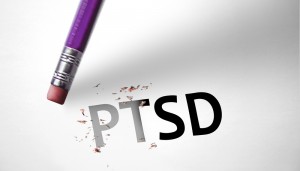
Post-traumatic stress disorder (PTSD) is a significant global issue. We know that a range of psychological interventions can help (Bisson & Andrews, 2007). We know too that in some cases, these interventions can work in an incredibly short space of time, say following a week of intensive cognitive therapy for PTSD (Ehlers et al, 2014).
However, and most importantly, we also know that there is an almost incalculable prevalence of untreated PTSD globally, particularly in conflict zones, following natural disasters or other areas where access to quality mental health services is at best limited, but often non-existent.
So the question that interests Morina et al in a new study published in Clinical Psychology Review is; what happens when PTSD goes untreated? Or more specifically, what data is there on remission rates based on long-term outcome studies, and how does this differ depending on the nature of traumatic exposure?

Despite good evidence for psychological therapies, many people with PTSD do not receive treatment
Methods
The authors searched PubMed, PsycINFO and the PILOTS database (US National Centre for PTSD) for observational studies published since 1980; when PTSD first appeared as a formal diagnosis in the DSM-III. The authors also hand searched several relevant journals and performed an iterative bibliography search on citations published in selected articles. Inclusion criteria for studies were as follows:
- A sample size of at least 40 participants
- A prospective design
- At least 80% of participants aged over 17 years
- Includes a report of remission rates in PTSD
- Use of a standardised measure of PTSD, based on DSM or ICD criteria
- A follow-up length of at least 10 months after assessment
- A report of response and drop-out rates
- A majority of participants were not treated for PTSD during the study
The study’s primary outcome was the percentage of participants meeting criteria for PTSD at assessment (baseline), but not at follow-up – the length of which varied between studies.
A random effects model was used, because analysis showed substantial heterogeneity of data. Similarly, because prospective studies are prone to large drop-out rates, an overall prevalence rate of PTSD in drop-outs was calculated (which, incidentally, suggested that PTSD rates were 1.3 times higher in drop-outs).
Meta-analytic regression was used to explore factors affecting variance in remission rates. The following possible predictors were identified:
- Length of time between traumatic exposure and baseline assessment
- Length of time between baseline and follow-up assessment
- Type of trauma (e.g. prolonged or abbreviated)
- Nature of trauma (including conflict-related events, natural disasters, interpersonal violence, terrorism, accidental injury, disease/physical illness, fire/explosion, imprisonment, death of a significant other, or any combination of these)
The initial search produced 21,029 citations; a review of which led to 99 eligible studies. A further 57 studies were excluded due to duplications or missing data. Therefore, a total of 42 studies were included, with an aggregate sample of 81,642 participants (mean age 42.3, SD=11.7, 48.8% male) spanning five continents.
Results
Overall, the mean effect size for PTSD remission was 0.75 (95% CI=0.68 to 0.83, k=42, I²=97%). Essentially, this equates to a remission rate of 44% after a mean of 40 months.
Studies whose baseline assessments were conducted within five months of traumatic exposure reported remission rates of 51.7% (ES=0.84). This was significantly higher than studies whose baseline assessment was later than five months following trauma, where remission rates were 36.9 % (ES=0.68).
No other characteristics of the included studies (e.g. demographic data, or presence of co-morbid depression or anxiety at assessment) were significantly associated with PTSD remission rates.
Regarding nature of trauma, exposure to natural disasters had the highest remission rate (60.0%), which was significantly higher than trauma relating to physical illness, such as heart attack or brain haemorrhage (31.4%). There were no other significant differences in remission rates relating to nature of traumatic event.

This review found an overall natural remission rate for PTSD of 44% (after a mean of 40 months)
Discussion
The authors began by highlighting that, particularly after a follow-up of ten months or more, the rate of remission in PTSD varies greatly. But importantly, they identified that it does not increase over time:
Perhaps most surprising is the finding that remission from PTSD does not increase with longer observation periods… The reviewed studies do not support the notion that “time heals all wounds”.
The authors rightly identified that future research should focus on preventative interventions for PTSD, as well as treatments.
They hypothesised that the low PTSD remission rate following traumatic physical illness could be explained by the potentially chronic nature of ongoing physical problems inhibiting their ability to recover psychologically.

This reviews suggests that remission from PTSD does not increase with longer observation periods. In other words, time does not heal all wounds
Limitations
There was considerable heterogeneity in the data. For example, a range of PTSD assessment measures were used and follow-up length was broad.
Several factors, such as co-morbid depression or anxiety, weren’t featured in the majority of the studies, so findings in these areas are limited. Similarly, data on rates of remission from childhood trauma were not included in the study.
As the authors identified, the self-report measures of PTSD focused on symptoms within the previous month. This may produce a false positive in remission rates, where people were asymptomatic during that time, however were not fully in remission.
Another important limitation for me is that many other factors, such as peri-traumatic psychological processes and access to social support have a huge part to play in the development and maintenance of PTSD. This study tells an important part of the story, but there are many more processes that require our full understanding, as these will guide future treatments. Put simply, who naturally recovers from PTSD and why?

Who naturally recovers from PTSD and why?
Summary
In some respects, this study tells us a huge amount. It tells us, for example, that just under half of people with PTSD will experience natural remission after a (very approximate) average of a few years. It does so using a large sample size which crosses five continents. It also tells us that people who are exposed to natural disasters are significantly more likely to recover than those with a physical illness, however no other differences regarding nature of trauma were observed. Importantly, the study also tells us that, for those whose symptoms persist, they do so regardless of length of follow-up.
This begs the question though, what distinguishes those who naturally recover from those who don’t? In this respect, the study tells us very little and clinically, this is crucial information (though arguably this was not in the study’s remit). Furthermore, despite the large sample size, considerable heterogeneity undermines the strength of the findings.
Links
Morina, N., Wicherts, J.M., Lobbrecht, J. & Priebe, S. (2014). Remission from post-traumatic stress disorder in adults: A systematic review and meta-analysis of long term outcome studies. Clinical Psychology Review, 34, 249-255. [PubMed abstract]
Bisson JI, Roberts NP, Andrew M, Cooper R, Lewis C. Psychological therapies for chronic post-traumatic stress disorder (PTSD) in adults. Cochrane Database of Systematic Reviews 2013, Issue 12. Art. No.: CD003388. DOI: 10.1002/14651858.CD003388.pub4.
Ehlers, A., Hackmann, A., Grey, N., Wild, J., Liness, S., Albert, I., … & Clark, D. M. (2014). A randomized controlled trial of 7-day intensive and standard weekly cognitive therapy for PTSD and emotion-focused supportive therapy. American Journal of Psychiatry, 171(3), 294-304. [PubMed abstract]


And if we do nothing? A new systematic review explores natural PTSD remission rates: Who naturally recovers fr… http://t.co/0RloRgoR0X
RT @Mental_Elf: And if we do nothing? A new systematic review explores natural PTSD remission rates http://t.co/konAtH9Q9B
New mental Elf blog: And if we do nothing? A new systematic review explores natural PTSD remission rates http://t.co/Ww2TOklakk
@paddy_kw summarises a meta-analysis of long term outcome studies, which looks at PTSD remission in adults http://t.co/xalr8R2xBA
Kirsten Corden liked this on Facebook.
Review finds an overall natural remission rate for PTSD of 44% (after a mean of 40 months) http://t.co/xalr8R2xBA
Mental Elf: And if we do nothing? A new systematic review explores natural PTSD remission rates http://t.co/CnStlF6d8Q
Who naturally recovers from PTSD and why? Read @paddy_kw’s blog of a recent Clinical Psychology Review paper http://t.co/xalr8R2xBA
@Mental_Elf @Paddy_kw But is there really this “almost incalculable prevalence of untreated PTSD globally, in conflicts, natural disasters”?
A new systematic review explores natural PTSD remission rates http://t.co/Fw6fBFZljn #ptsd #mentalhealth
New systematic review explores natural PTSD remission rates http://t.co/Ix6OSZ5OZS
Thoughts on this review of PTSD remission rates? http://t.co/xalr8R2xBA @EvaAlisic and other trauma tweeps
Interesting for @smidjorgensen re Delayed PTSD. RT @mental_elf Thoughts on this review of PTSD remission rates? http://t.co/DRXJGkQx95
@EvaAlisic @Mental_Elf A complementing view. They did the opposite of what we did: we looked at delayed PTSD (% new cases at follow-up).
Interesting start but needs a lot more work RT @Mental_Elf: Thoughts on this review of PTSD remission rates? http://t.co/3rT8rnwep7
Hampshire Healthcare Library Service liked this on Facebook.
This was a very interesting read and I’m pleased you managed to get such a large sample size. I only have experience as someone who once had PTSD and sometimes wonder what life would be like if I’d not managed to get treatment. It would be fascinating to find out what helps people get over it without treatment, especially as people who haven’t experienced it have a ‘pull yourself up by your bootstraps’ attitude. Perhaps, they’re right after all?
Very good point Sarah. I agree.. The deeper questions regarding who recovers and why are essential here. So too are questions regarding the development of PTSD in the first place. Although I think this paper’s remit was more around rates of remission. Check out the work of Anke Ehlers, David Clark and others at the Oxford Centre for Anxiety Disorders and Trauma, who tackle some of these questions.
Don’t miss: And if we do nothing? A new systematic review explores natural PTSD remission rates http://t.co/konAtH9Q9B
@Mental_Elf @Paddy_kw Interesting review on natural PTSD remission rates http://t.co/u1M3iAFkEx #PTSD
And if we do nothing? A new systematic review explores natural PTSD remission rates http://t.co/WTVvLLDvun via @sharethis
Nicola Davies liked this on Facebook.
And if we do nothing? A new systematic review explores natural PTSD remission rates #thementalelf http://t.co/7QsOXWg95I
A new systematic review explores natural PTSD remission rat
http://t.co/bfO9XpRMMw via @sharethis
The Mental Elf liked this on Facebook.
The Mental Elf liked this on Facebook.
Nicola Davies liked this on Facebook.
Hampshire Healthcare Library Service liked this on Facebook.
Kirsten Corden liked this on Facebook.
Recovery is an interesting idea – who forgets or can distance themselves from their reality and who recalls their trauma with night Mariah clarity. Counselling would seem counter intuitive. The army likes to keep the peer group together and give their service men and women repetitive tasks, this unlike my photo seems right way up. Nigel